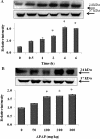Acetaminophen-induced hepatotoxicity in mice occurs with inhibition of activity and nitration of mitochondrial manganese superoxide dismutase
- PMID: 21205919
- PMCID: PMC3063736
- DOI: 10.1124/jpet.110.176321
Acetaminophen-induced hepatotoxicity in mice occurs with inhibition of activity and nitration of mitochondrial manganese superoxide dismutase
Abstract
In overdose the analgesic/antipyretic acetaminophen (APAP) is hepatotoxic. Toxicity is mediated by initial hepatic metabolism to N-acetyl-p-benzoquinone imine (NAPQI). After low doses NAPQI is efficiently detoxified by GSH. However, in overdose GSH is depleted, NAPQI covalently binds to proteins as APAP adducts, and oxygen/nitrogen stress occurs. Toxicity is believed to occur by mitochondrial dysfunction. Manganese superoxide dismutase (MnSOD) inactivation by protein nitration has been reported to occur during other oxidant stress-mediated diseases. MnSOD is a critical mitochondrial antioxidant enzyme that prevents peroxynitrite formation within the mitochondria. To examine the role of MnSOD in APAP toxicity, mice were treated with 300 mg/kg APAP. GSH was significantly reduced by 65% at 0.5 h and remained reduced from 1 to 4 h. Serum alanine aminotransferase did not significantly increase until 4 h and was 2290 IU/liter at 6 h. MnSOD activity was significantly reduced by 50% at 1 and 2 h. At 1 h, GSH was significantly depleted by 62 and 80% at nontoxic doses of 50 and 100 mg/kg, respectively. No further GSH depletion occurred with hepatotoxic doses of 200 and 300 mg/kg APAP. A dose response decrease in MnSOD activity was observed for APAP at 100, 200, and 300 mg/kg. Immunoprecipitation of MnSOD from livers of APAP-treated mice followed by Western blot analysis revealed nitrated MnSOD. APAP-MnSOD adducts were not detected. Treatment of recombinant MnSOD with NAPQI did not produce APAP protein adducts. The data indicate that MnSOD inactivation by nitration is an early event in APAP-induced hepatic toxicity.
Figures






References
-
- Bayir H, Kagan VE, Clark RS, Janesko-Feldman K, Rafikov R, Huang Z, Zhang X, Vagni V, Billiar TR, Kochanek PM. (2007) Neuronal NOS-mediated nitration and inactivation of manganese superoxide dismutase in brain after experimental and human brain injury. J Neurochem 101:168–181 - PubMed
-
- Beckman JS. (1996) Oxidative damage and tyrosine nitration from peroxynitrite. Chem Res Toxicol 9:836–844 - PubMed
-
- Boobis AR, Tee LB, Hampden CE, Davies DS. (1986) Freshly isolated hepatocytes as a model for studying the toxicity of paracetamol. Food Chem Toxicol 24:731–736 - PubMed
-
- Burcham PC, Harman AW. (1991) Acetaminophen toxicity results in site-specific mitochondrial damage in isolated mouse hepatocytes. J Biol Chem 266:5049–5054 - PubMed
Publication types
MeSH terms
Substances
Grants and funding
LinkOut - more resources
Full Text Sources
Other Literature Sources
Medical

